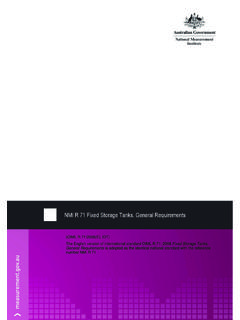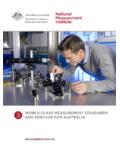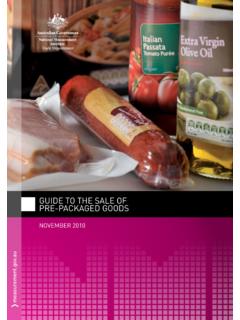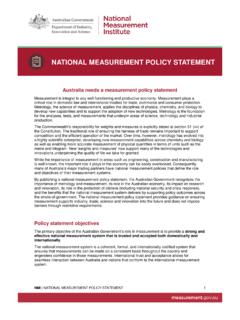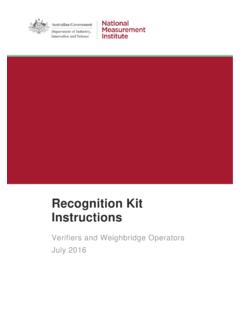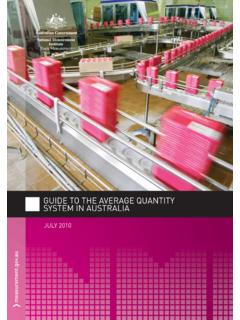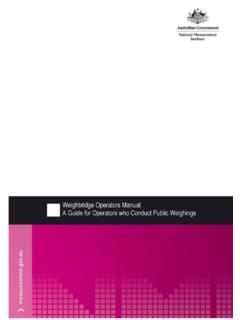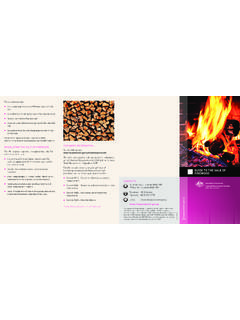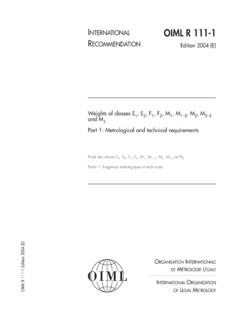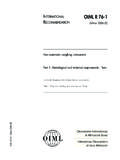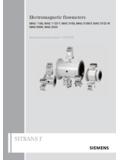Transcription of OIML R60-1 WD - National Measurement Institute, …
1 3rd Committee Draft oiml /3CD Reference number: oiml R60-1 3CD Supersedes document: R60 (2000) oiml TC 9 : Instruments for Measuring Mass and Density Circulated to P- and O-members and liaison international bodies and external organizations for: Title: Metrological Regulation for Load Cells Part 1: Metrological and Technical Requirements Part 2: Metrological controls and performance tests TITLE OF THE CD (English): oiml R 60- Parts 1 and 2 Metrological Regulation for Load Cells Part 1: Metrological and Technical Requirements Part 2: Metrological controls and performance tests TITRLE DU CD (French): oiml R 60-1 et -2 R glementation m trologique des celleules de pes e Partie 1: Exigences m trologiques et techniques, Partie 2: Contr les m trologiques et essais de performance Original version in: English Part 1 oiml R60: 2013 1 Contents PART 1 METROLOGICAL AND TECHNICAL REQUIREMENTS 2 1.
2 INTRODUCTION 2 2. SCOPE 2 3. TERMINOLOGY (TERMS AND DEFINITIONS) 4 GENERAL DEFINITIONS 4 CATEGORIES OF LOAD CELLS 5 CONSTRUCTION OF LOAD CELLS 5 METROLOGICAL CHARACTERISTICS OF A LOAD CELL 6 RANGE, CAPACITY AND OUTPUT TERMS 7 ILLUSTRATION OF CERTAIN DEFINITIONS 9 Measurement AND ERROR TERMS 10 INFLUENCES AND REFERENCE CONDITIONS 11 ABBREVIATIONS 12 4. DESCRIPTION OF LOAD CELLS 12 5. UNITS OF Measurement 12 6. METROLOGICAL REQUIREMENTS 12 PRINCIPLE OF LOAD CELL CLASSIFICATION 13 MEASURING RANGES 15 MAXIMUM PERMISSIBLE Measurement ERRORS 16 REPEATABILITY ERROR 17 PERMISSIBLE VARIATION OF RESULTS UNDER REFERENCE CONDITIONS 18 INFLUENCE QUANTITIES (RATED OPERATING CONDITIONS) 18 REQUIREMENTS FOR LOAD CELLS EQUIPPED WITH ELECTRONICS 20 7.
3 TECHNICAL REQUIREMENTS 24 SOFTWARE 24 INSCRIPTIONS AND PRESENTATION OF LOAD CELL INFORMATION 25 PART 2 METROLOGICAL CONTROLS AND PERFORMANCE TESTS 30 8 METROLOGICAL CONTROLS 30 LIABILITY TO LEGAL METROLOGICAL CONTROLS 30 RESPONSIBILITY FOR COMPLIANCE WITH THE REQUIREMENTS 30 9 TYPE EVALUATION 30 SCOPE 30 TEST REQUIREMENTS 31 SELECTION OF SPECIMENS FOR EVALUATION 31 SELECTION OF LOAD CELLS WITHIN A FAMILY 32 DOCUMENTATION 33 EXAMINATIONS 34 PERFORMANCE TESTS 34 RULES CONCERNING THE DETERMINATION OF ERRORS 37 VARIATION OF RESULTS UNDER REFERENCE CONDITIONS 39 TEST PROCEDURES 39 TEST SEQUENCE 61 oiml CERTIFICATE 62 ANNEX A (MANDATORY) DEFINITIONS FROM OTHER APPLICABLE INTERNATIONAL PUBLICATIONS A-1 ANNEX B (MANDATORY) oiml CERTIFICATE OF CONFORMITY FOR LOAD CELLS - FORMAT OF CERTIFICATE B-1 ANNEX C (INFORMATIVE) oiml CERTIFICATE OF CONFORMITY FOR LOAD CELLS C-1 ANNEX D (INFORMATIVE) SELECTION OF LOAD CELL(S) FOR TESTING - A PRACTICAL EXAMPLE D-1 ANNEX E (INFORMATIVE) LOAD TRANSMISSION TO THE LOAD CELL E-1 BIBLIOGRAPHY i oiml R60: 2013 Part 1 2 Part 1 Metrological and technical requirements 1.
4 Introduction The 3rd Committee Draft copy of oiml R60 Parts 1&2 represents changes to the previous 2nd CD based on the Project Group s (TC9 p1) comments. The subject of this Recommendation, load cells comprise a distinct element or module within other complex instruments. Load cells do not produce distinct quantitative values that are inherently identified or associated with denominations or units. The data that can be extracted from a load cell is simply a Measurement of change in the output of the load cell in relation to the input. This relative change must be converted by other elements or modules within an instrument into values that are meaningful measurements which can then be used to identify a quantity.
5 To assist the reader in the review of the formatting of this Third Committee Draft, the document has been placed in a tabular form using the following numbering scheme. As illustrated below in 2 Scope , the left-hand column contains reference numbers that are associated with the 2000 edition of R60. Paragraphs that appear without a reference number in the left-hand column represent new entries in the document. A significant change from the 2CD to the 3CD is the formatting of test procedures found in sections through These changes largely were done by copying tables from oiml D11 [1] and pasting them into this draft of oiml R60 with some editing done where it was considered appropriate.
6 Part 1 (Metrological and Technical Requirements) and Part 2 (Metrological Controls and Performance Tests) of this Recommendation are a combined publication, Part 3 (Test Report Format) is a separate document. 1 (2000 Ed.) 2. Scope Part 1 oiml R60: 2013 3 This Recommendation prescribes the principal metrological static requirements and static evaluation procedures for load cells used in the determination of conformity to this recommendation. It is intended to provide authorities with uniform means for determining the metrological characteristics of load cells used in measuring instruments that are subjected to metrological controls. It is acknowledged that test procedures found in Part 2 of this Recommendation (see section 9) are useful in the evaluation of load cells that are currently found in service ( , primarily strain gauge design) however, there may be variations in designs for load cells that will require additional or modified test procedures to appropriately evaluate them.
7 These additional test procedures may be annexed when necessary. Except where otherwise specified, these requirements apply regardless of the technology or operating principle employed. The requirements and evaluation procedures in this Recommendation have been drafted to be non-specific with regard to load cell design and their operating principles. This Recommendation utilizes the principle that several Measurement errors shall be considered together when applying load cell performance characteristics to the permitted error envelope. Thus, it is not considered appropriate to specify individual errors for given characteristics ( , non-linearity, hysteresis, effects of influence factors), but rather to consider the total error envelope allowed for a load cell as the limiting factor.
8 The use of an error envelope allows the balancing of the individual contributions to the total error of Measurement while still achieving the intended final result. Note: the error envelope may be defined as the curves that provide the boundary of the maximum permissible errors (see Table 4) as a function of the force introduced by the applied load (expressed in mass units) over the measuring range. The combined errors determined may be positive or negative and include the effects of nonlinearity, hysteresis and temperature. Weighing modules as per R76 [2], (see Annex A, ), are not covered by this recommendation. Weighing instruments that include load cells and which give an indication of mass are the subjects of separate Recommendations.
9 While digital load cells may be covered under this Recommendation, a load cell that produces an output consisting of more than digital raw counts will not be covered under R60. In the illustration from oiml R76 below, the scope of R60 would not extend beyond module #3. oiml R60: 2013 Part 1 4 From oiml R76: Definition of typical modules within a weighing system (other combinations are possible) Figure 1. Weighing Modules 2 3. Terminology (Terms and definitions) The terms most frequently used in the load cell field and their definitions are given below (see for an illustration of certain definitions). The terminology used in this Recommendation conforms to oiml V 1 International Vocabulary of Basic and General Terms in Metrology (VIM) [3], to oiml V 2 International Vocabulary of Terms in Legal Metrology (VIML) [4], to oiml D 9 Principles of metrological supervision [5], to oiml D 11 General Requirements for electronic measuring instruments [1], and to oiml B 3 oiml Certificate System for Measuring Instruments [6].
10 In addition, for the purposes of this Recommendation, the following definitions apply: General definitions load cell measuring transducer that, in response to an applied load will produce an output. This output may be converted by another device into Measurement units such as mass. Part 1 oiml R60: 2013 5 load cell equipped with electronics load cell employing an assembly of electronic components having a recognizable function of its own. Load cells that include intrinsically (as a minimum) the function of analog to digital output conversion, are referred to as digital load cells and are examples of load cells equipped with electronics.
